"There's an old saying about those who forget history. I don't remember it, but it's good." -Stephen Colbert
Let me start by telling you a story about an old problem. Take a look at the planet Mercury, one of the five planets (not counting Earth) visible in our night sky to the naked eye.
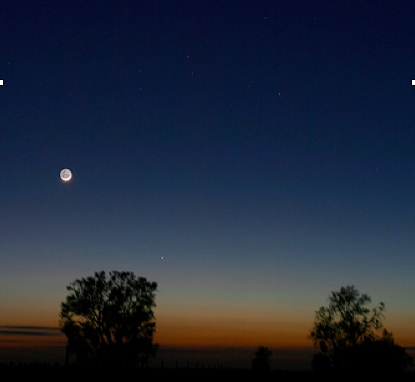
And I can see some of you at home squinting at your screen, asking why I'm showing you a picture of the Moon right after sunset. Well, Mercury's in that picture, I promise. Let me make it a little easier for you.

No less a naked-eye astronomer than Copernicus had difficulty seeing the planet Mercury, and near most cities around the world it's completely invisible. And surprisingly, light pollution isn't the only reason.
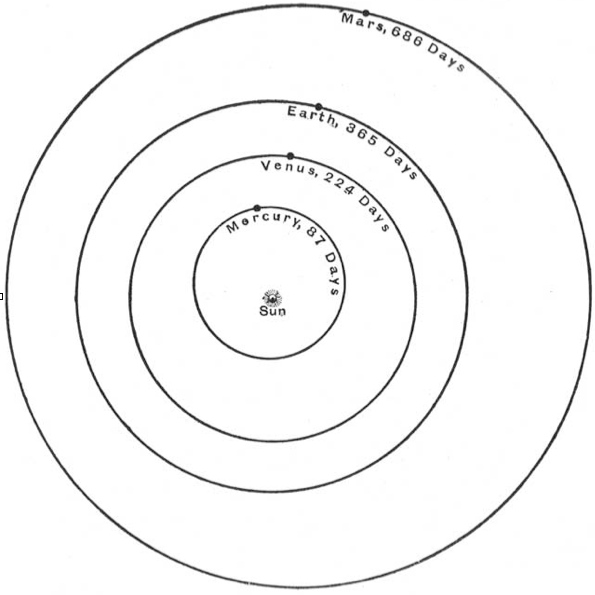
Because of its extremely close proximity to the Sun, Mercury never appears more than 28 degrees away from it -- what astronomers call elongation -- in the sky.
Which means it's only ever visible close to the horizon, either shortly after sunset or shortly before sunrise. But if you plot the position of Mercury very accurately over time, you start to find something very unusual.
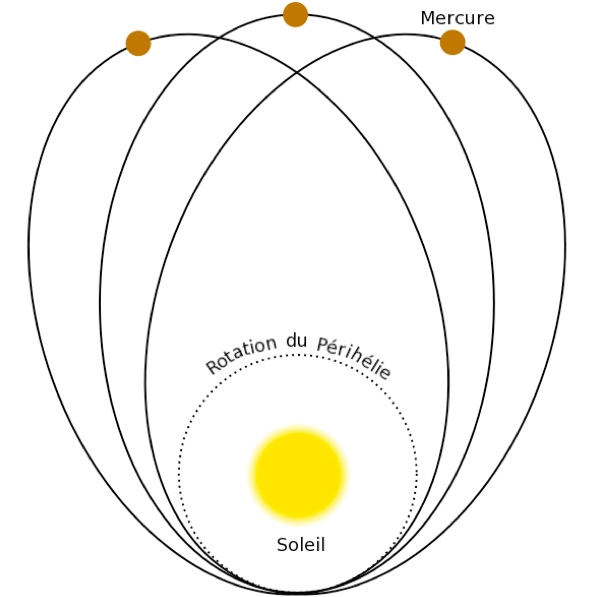
Unlike Kepler's Laws of Planetary Motion told us, Mercury doesn't move in a perfect ellipse with the Sun at one focus! Instead, its ellipse shifts over time, a process called precession. Now, we knew of two things that caused precession: the Earth's equinoxes precessing (which is why the pole star shifts with a period of 26,000 years) and the gravitational forces of the other planets.
But that didn't explain all of it. So we had our theories of planetary motion and gravitation, and they didn't line up completely with our observations. What were our options?

1.) Maybe there was a new planet! This idea -- that an extra gravitational force from an unseen planet affects the orbit of a visible planet -- is how we found Neptune, the planet outer to Uranus. Well, maybe we could find one interior to Mercury! It's a nice idea, but this hypothetical planet, named Vulcan, simply isn't there.

2.) Maybe Newton got that exponent slightly wrong. In Newton's law of Universal Gravitation, the gravitational force is inversely proportional to the distance squared. In other words, if you're twice as far away, the force is only one quarter, and if you're 10 times as far away, the force is only one one-hundredth. It was suggested that instead of a "2" in the exponent, the number should actually be "2 plus a tiny bit," which would explain Mercury's motion.
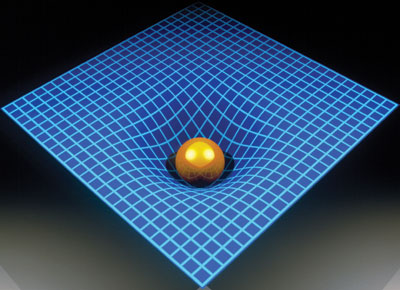
3.) Gravity doesn't work according to Newton's Laws at all, but instead works by matter and energy bending spacetime. This was Einstein's theory of General Relativity, and it totally accounted for the discrepancy between what was predicted and observed pretty much exactly!
So which of these ideas was the right one? Any one of them is reasonable, so what you have to do is test it.
And it won't do you any good to test it for the thing it was designed to do, you need to test it doing something new.
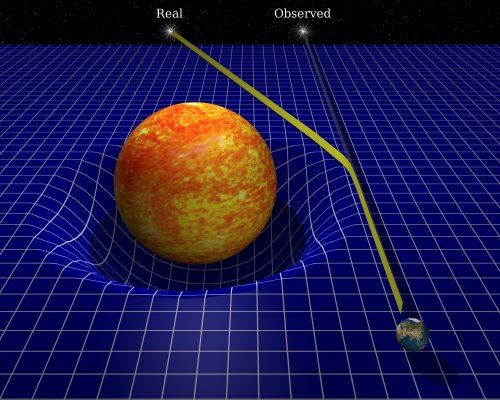
So in 1919, they did. (You can read the detailed story here.) One of the more bizarre predictions of Einstein's General Relativity was that near a strong gravitational source (like the Sun), mass would bend light! And not only was it predicted, but Einstein's theory predicted the amount that light would bend, too!
So they organized an expedition to Brazil in 1919 to watch the Total Solar Eclipse, where they prepared to watch the stars during the day, when they appeared nearest to the Sun, and compare them to where they appear during the night!
And sure enough, the shift in the stars' apparent position matched Einstein's theory, and no one else's!
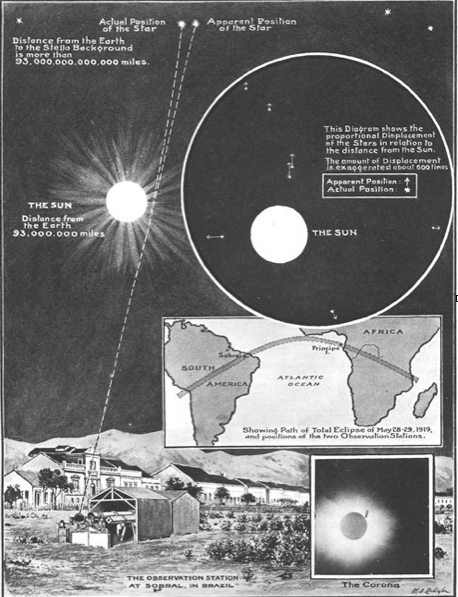
And since then, there have been a whole suite of disconnected, but very precise observations -- gravitational lensing, the gravitational redshift of light, gravitational frame dragging, the Shapiro time delay, the decay of binary pulsar orbits, etc. -- that confirm it. So we think we have the correct explanation for Mercury's perihelion shift.

So what do you do when you look up at galaxies and galaxy clusters -- like Abell 1689 as imaged by Hubble -- and find that the amount of mass you find in stars isn't enough to explain the motions that you see, consistent with the laws of physics that you know?
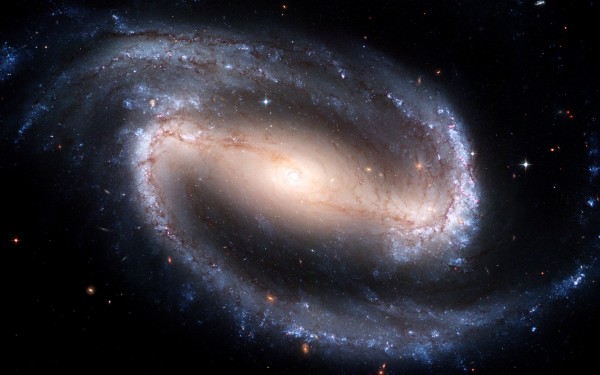
Well, you've got two options again: you can either assume there's more matter than you can detect, or you can change the laws of gravity. Not surprisingly, both camps have strong adherents.
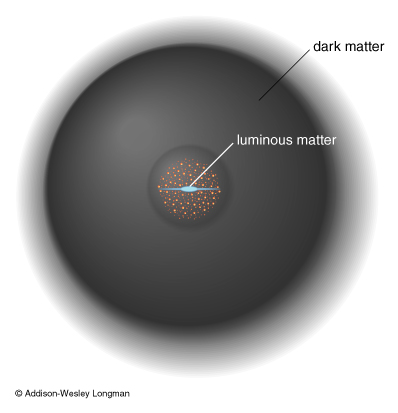
Dark matter -- the idea there's a new type of matter than exerts a gravitational force -- has been around since the 1930s. And it has given us a whole slew of cosmic successes, including the ability to predict how large scale structure forms and matter clumps together.
Dark matter also gives us a model for how galaxy clusters collide. Note below, the discrepancy between where the normal, gaseous matter is (in pink), and where the mass is (in blue). Without dark matter, this is virtually impossible to explain.
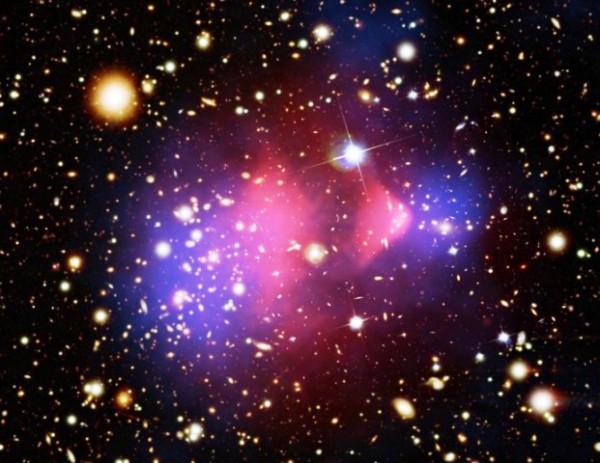
And perhaps in its greatest success, dark matter predicts the same patterns of fluctuations we observe in the Cosmic Microwave Background!
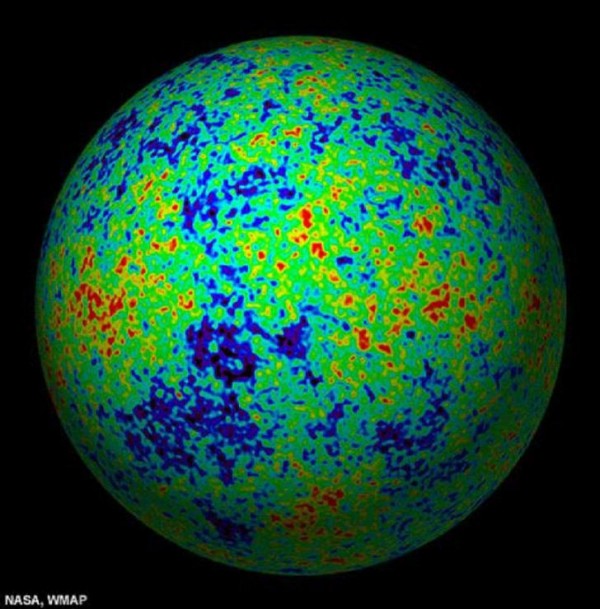
Take dark matter away, and we can reproduce none of these things. Want more details? Check out parts 1, 2, 3, 3.5, and 4 of my series on Dark Matter.
So what about the competitor: what about modifying gravity?
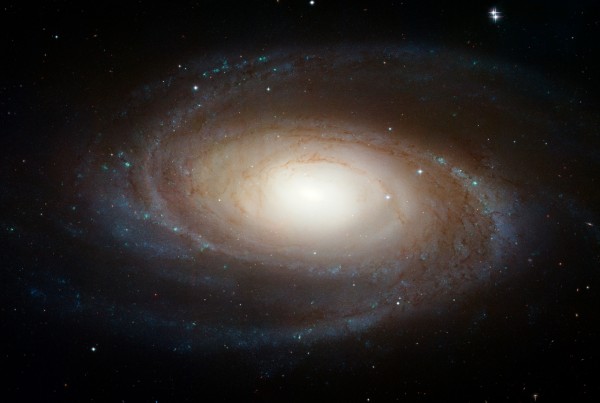
Back in 1983, some scientists looked at rotating galaxies like M81 -- imaged by Hubble -- above. And rather than trying to add dark matter to explain their rotation curves, they made a modification to Newton's old law of gravity.
And it worked! You can, in fact, explain the rotation curves of most (but not all) types of galaxies by making that modification. This idea of Modified Newtonian Dynamics is known as MOND, and it works very well for explaining the rotation curves of individual galaxies. In fact, arguably, this is something MOND does even better than dark matter!
But then we come to the other stuff. (Sean Carroll has a great writeup of this, BTW.) And, particularly for the Microwave Background, MOND fails spectacularly. Let's take a look at what we observe. Not showing the fluctuations in the sky, but the data points we get if we plot temperature fluctuations vs. angular size.
The data points are shown as x's with error bars, the dotted line is Dark Matter's predictions, and the solid line is MOND's predictions. In this case, even the painstaking relativistic version cannot match Dark Matter's accurate predictions. The third little peak at the end is the killer; it simply isn't strong enough with MOND under any circumstances.
Which is why it kills me every time (and it happens about twice a year) a story like this comes out.
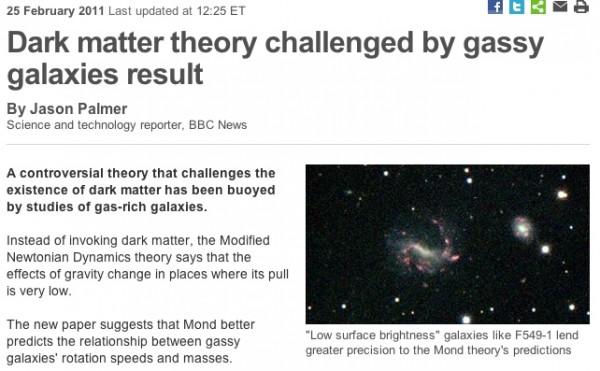
Are you kidding me?! This time Stacy McGaugh, who I've met twice now, is looking at low surface brightness galaxies and declaring that MOND works and dark matter doesn't.
MOND WAS DESIGNED TO WORK FOR ROTATING GALAXIES! The problem is it doesn't do anything else. And its adherents never point to anything other than rotating galaxies to support it.
I wrote about this, angrily, over a year ago, and it doesn't seem to change. So maybe I need to be a little clearer.
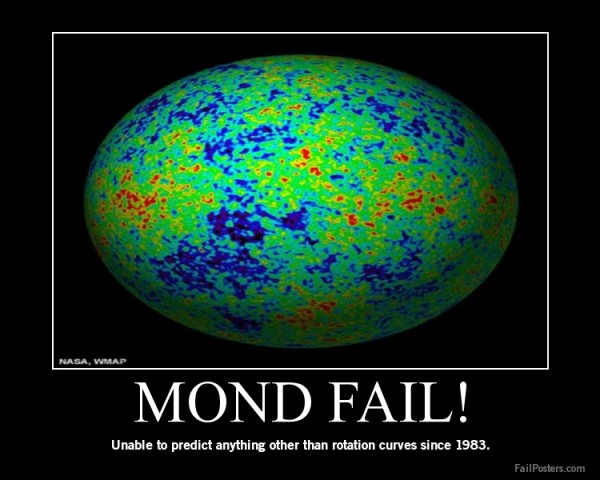
If you want to be taken seriously as a theory, you need to do more than just the one thing you were designed to do. Otherwise, you're in the "Vulcan" category.
All of this isn't to say that MOND isn't an interesting idea, or that the people working on it are frauds. But what's being reported is grossly misleading at best, and blatantly dishonest at worst. General Relativity could still need fixing, and there could be something else going on with gravity beyond dark matter. But we still need dark matter -- or something heretofore indistinguishable from it -- to explain all our large-scale observations.
And definitively, however you slice it, whether there's any validity to it or not, MOND certainly isn't an alternative to dark matter. And everyone, even Stacy McGaugh, knows it.


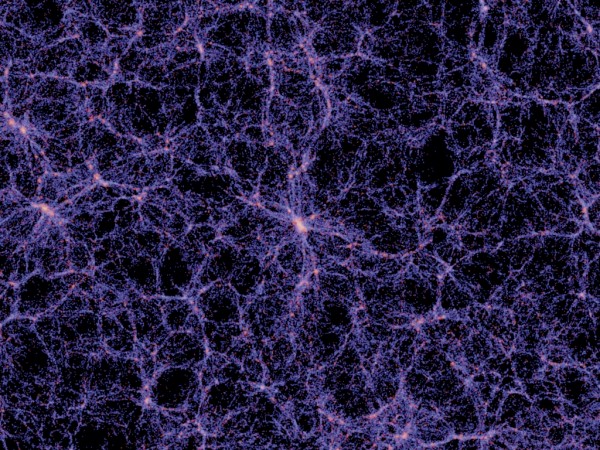

I am quite green on this subject and so likely misinformed, and so this is likely a naive question, but about dark matter: If dark matter does not interact with light, why is gravitational lensing sometimes mentioned as evidence of dark matter? (Thx!)
I laughed very hard at your "MOND Fail!" poster. That is some high quality humor.
Oh, and the rest of the post was good, too. Yep.
You know you've learned something from a blog when you recognize the picture and get the joke--not just get that it is a joke, but actually understand the joke--with a poster with such an economy of words and image.
Are dark matter and MOND inconsistent in rotation curves? That is, if MOND, then no dark matter halo, and vice versa?
After all, you have the McGaugh types who are willing to say that there exists dark matter, but it's not responsible for galaxy rotational curves. If that's the case, what's all the dark matter doing? How can you have the Bullet Cluster lensing and MOND?
BLACK HOLES, EXPANSION, AND DARK ENERGY
In the continuum of space and time, exists the dichotomy of matter and energy. All things exist as both matter and energy, but are experienced as one or the other.
As energy, all things exist as wave patterns. Most wave patterns are interferences of simpler wave patterns. The simplest wave forms are those that do not interfere with other waves. These simplest wave forms hold their shape as they propagate. There are three such wave forms.
The first such wave form is seen in three dimensions as the spherical expansion wave of a bomb blast, and in two dimensions as the circular wave of expansion on the water where a rock was tossed in. The second wave form is seen in three dimensions as the cone of sonic boom following an aircraft traveling faster than sound, and in two dimensions as the V-wake on the water where the boat is traveling faster than the water wave. The third wave form is seen in three dimensions as the propagation torus of a smoke ring and is seen in two dimensions as the double vortexes of an oar stroke on the water.
The Torus is a particle of discrete exchange, from one point to another. The object exchanges position and momentum. While the spherical wave shows position, and the conic wave shows momentum, the torus shows both at the same time, and has a dynamic finite unbounded reality. The volumes of the cone, sphere, and torus are mathematically related as static objects.
The Universe is a local density fluctuation. (a wave pulse) On this local density fluctuation wave, lesser wave forms may exist. All simple wave forms are also local density fluctuations, and as such are indeed universes in their own right, where other waves may exist.
Consider the torus as a universe. Einstein said that gravity is indistinguishable from acceleration. There is both linear acceleration and angular acceleration. Although the torus as a whole travels in a straight line, every local point on the torus travels in a circle and experiences angular acceleration.
The rubber sheet model of gravity and curved space translates directly to the propagating torus with angular acceleration. Acceleration is downward on the rubber sheet and outward on the torus. The tension field that separates the inside of the torus from the outside holds its shape as a simple two dimensional field of space and time just as the rubber sheet does.
Experimentally verifiable is that a big fat slow smoke ring generated in a room with very still air will eventually possess a bulge that travels in a circle on the surface of the smoke ring. This bulge, being a gravitational depression, gathers more of the energy of the field toward itself. Finally the bulge gathers enough material to collapse the field and eject a new, smaller smoke ring out in the same direction as the first torus. This collapse is a black hole to the first torus, and a white hole to the second torus, where the axes of space and time in that second torus have reversed.
While gravity tends to draw depressions together locally on a dynamic torus, even to the point of field collapse, other areas on a torus expand and contract globally as the torus propagates along without regard to local phenomenon on the surface. This is quintessence. The inertia of the torus to propagate is its dark energy. This is a two-dimensional example of the process that we experience in three dimensions.
From structureofexistence.com by Dan Echegoyen 951-204-0201
--
Ethan, you're a hell of a teacher. On one hand I can understand people being oogy about dark matter. Dirac invented the positron because his equation used absolute values. Now we're shooting beams of them at LHC. Pauli and Fermi invented the neutrino because beta decay violated conservation laws. They were later found, and in lots of varieties. So my world view and cosmology is not too disturbed by some 'stuff' that we cannot observe by its interactions with photons. We're just kind of photonic beings. Dogs rely on smell. We can barely smell. Big deal.
Ethan, I'm entirely ready to agree with you that press releases, and worse, press reports over such research, can be misleading. So yes, we (almost) all agree (at least I do) that dark matter of some kind must exist, to explain large-sacle structures. That said, more than a hundred rotation curves of galaxies (nearby-enough to measure their rotation curve accurately) agree with the mond scaling relation (that is, pretty much all of them). By the way, that's what mond is, above all the rest: simply a succesful scaling relation for spirals and ellipticals, summarizing many otherwise independent scaling relations about them. That is an observational *fact*. This clearly poses a fine-tuning problem to LambdacDM, and that is what you are putting under the carpet here. To make this fine-tuning problem clear, in LambdaCDM, the respective distribution of baryons and CDM should depend on the individual history of each galaxy (number of mergers, interactions with the environment, gas accretion, etc.), and yet all of them seem to harbor the same scaling relation (the mond scaling relation) at redshift zero-ish. I am surely ready to admit that this does *not* imply that the only solution is an extreme one such as modified gravity, and to admit that something we dont fully understand yet could be happening in the process of galaxy formation in the context of LambdaCDM. But what I find damaging is to completely ignore such observational evidence because we dont fully understand it yet. And until an explanation has been found (and/or until CDM has been detected directly), I think it is also dangerous to call for not exploring alternative explanations (and yes we agree, these should involve the existence of dark matter of some kind, be it HDM in the form of sterile neutrinos + modified gravity, or mass-varying axions inducing modified gravity effects, or dipolar dark matter, or the âtwin matterâ of Milgromâs bimetric theory, or whateverâ¦), even though I also agree that these often end up having usually their own theoretical or phenomenological problems. But we find such problems thanks to people working on them, and that is why they are not frauds. So the bottom-line is "yes dark matter exists", but for "MOND fails", it's a more shaky statement. MOND, as a successful scaling relation for spirals and ellipticals (and, in that sense, it does *not* fail in its domain of application), could just be a consequence of the behavior of some classical or less classical form of dark matter. So I find this whole debate slightly tiring, because as an old Chinese proverb says, "If the wiseman shows the moon, the fool looks at the finger"...
Great post. Thanks for the "grav near a massive body" link, too.
Ethan, let me begin with a slight modification of your words. (the words in parentheses are mine).
"So what do you do when you look up at galaxies ... and find that the amount of mass you find in stars isn't enough to explain the motions that you see, consistent with the laws of physics (i.e. Newtonian Gravity) that you know? Well, you've got two (three) options again: you can either assume there's more matter than you can detect (i.e. apparent dark matter), or you can change the laws of (Newtonian)gravity, (or you can test your observations against predictions of the gavitational theory of General Relativity). Not surprisingly, both camps have strong adherents (but not until recently has the General Relativistic calculation been done)."
"Back in 1983, some scientists looked at rotating galaxies... And rather than trying to add dark matter to explain their rotation curves, they made a modification to Newton's old law of gravity. And it worked! You can, in fact, explain the rotation curves of most (but not all) types of galaxies by making that modification. This idea of Modified Newtonian Dynamics is known as MOND, and it works very well for explaining the rotation curves of individual galaxies. In fact, arguably, this is something MOND does even better than dark matter!" (But when were General Relativitic calculations applied to galactic models?"
The problem with beating up the MOND idea is that there already is an improved and accepted theory that replaces Newtonian Gravity; it is called General Relativity.
And the relevant point is that astronomers have not made the effort to apply General Relativity to the observations suggesting some kind of "apparent dark matter". Fred I. Cooperstock (emeritus professor of General Relativity) "wonders how different physics might have evolved had the early astronomers made themselves more knowledgeable about general relativity and made the kinds of calculations for galactic velocities that we have described in this book." General Relativistic Dynamics (Extending Einstein's Legacy Throughout the Universe), 2009.
In that book, Cooperstock asserts, "Einstein's general theory of relativity, could account for the observed flat galactic rotation curves without the requirement for vast stores of mysterious dark matter." In other words, the entire idea that vast quantities of invisible "dark matter" are the dominant form of matter in our visible universe is flawed from its first conception; because it is based upon the incorrect assumption that Newtonian gravity is a sufficient gravitational theory at the galactic level.
Now Yes, Ethan commented 9/24/2009 regarding Cooperstock. Ethan said, "My conclusion? His model is interesting in principle, but he applies it incorrectly. It is possible to have the thing he suggests, but it is not a galaxy." Why not, I protest; that really isn't an explanation of what is wrong with Cooperstock's model. Unless you accept Ethan's preposterous suggestion that Cooperstock doesn't know what a galaxy is, "but it is not a galaxy." Do you, Ethan, seriously suggest that Cooperstock did all of the general relativity calculations correctly but that he accidently used the wrong definition of a galaxy? I grant he used a simple model for a galaxy; but that does not invalidate his conclusion; rather it calls for even more precise calulations.
Here's my interpretation. "Back in 1983, some scientists (developed)... This idea of Modified Newtonian Dynamics is known as MOND," because it was much too difficult to test the observations against theory of General Relativity calculations.
But in 2005, 2006 and 2007 ref 63 to 66 (e.g. Mod. Phys. Lett. A. 21, 2133); F. I. Cooperstock and S. Tieu published those calculations.
As of Sept 2009, Cooperstock said, "You should know that while we have answered all of our critics, to my knowledge, there has not been any counter-criticism, at least not in print."
So here in this blog Ethan would be a good place for you to start with a criticism of General Relativity as it pertains to the "apparent galactic dark matter". Your previous remark that Cooperstock's model "is not a galaxy" is a cop-out. Cooperstock's model is ENOUGH to show that the Newtonian gravity is NOT sufficient for the weak gravitational field situation of a galaxy (even if his model isn't a perfect galaxy); and thus the Newtonian Gravity assumption of MOND and "apparent dark matter" theorist is FAR FROM ADEQUATE.
Astrophysicist continue to ignore the second order effects of General Relativity regarding the apparent missing mass in galaxies; and continue to insist that Newtonian gravity is sufficient for weak gravitation situations on a galactic scale (contrary to Cooperstock's calculations). This ignoring of the results of General Relativity calls into question the whole line of thinking regarding other interpretations of so called "dark matter observations."
As you say Ethan, "there have been a whole suite of disconnected, but very precise observations" supporting General Relativity. So why do you choose to ignore the results of General Relativity now regarding the "apparent galactic dark matter"?
When I say press reports can sometimes be misleading, this one was a pretty good example: http://www.planetary.org/news/2007/0515_Invisible_Ring_of_Dark_Matter.h… , while we now know that this ring is an artefact due to the connection between strong and weak lensing data, not a "dark matter" ring. In comparison, some press reports about Stacy McGaugh's research might be a bit too strong (but certainly not his press release), in the sense that these reports should talk about evidence against "cold dark matter" instead of against "dark matter", but that's nothing in comparison of exagerations one often reads in the other sense. In the Chinese proverb, the moon is thus the correct theory that will hopefully one day describe all scales accurately, while the finger is "MOND fails in the bullet cluster without additional dark matter". I let you guess who is the fool.
Ben
MOND seems to get a fair amount of reasonably good press.
Whereas the General Relativity calculations of Cooperstock get no press at all.
Is it possible that MOND is somehow an approximation of General Relativity (i.e. Cooperstock's work)?
On page 124 of his book, Cooperstock uses Bessel functions to analyze the Milky Way and he says, "Also, the present curves (of Cooperstocks's work) drop as r approaches 0. This is in contrast to the alternative proposed means of accounting for the rotational curves given by L. Mestel and MOND authors that lead to flat plots even up to r = 0." In italics on page 125 Cooperstock says, "The essential point is this: the matching of the flat velocity curve is achieved in general relativity with confined mass in the disk up to an order of magnitude smaller than the envisaged halo mass of exotic dark matter." His disclaimers and footnotes of course apply.
Note re MOND on page 124 Cooperstock references results from L. Metsel(1963), M.Milgrom (1983), M. Milgrom & J.D. Bekenstein (1984) and J.D. Berkenstein (1990). Of note the 1990 reference is from a book Developments in General Relativity, Astrophysics and Quantum Theory edited in part by Cooperstock.
At http://books.google.com/ you can search "General Relativistic Dynamics" and read part of Cooperstock's book but page 124 and 125 are not part of the preview.
It is interesting that neither dark matter nor mond correctly account for all the peaks in the graph (although dark matter certainly does a better job).
On the left side of the main peak there is a clear valley and a peak that are missed by both predictions, there also seem to be another valley and peak though masked by large error bars.
That BBC story even found it's way onto a german "astronomy news" webpage:
http://www.astronews.com/news/artikel/2011/03/1103-001.shtml
By the way, M Korzynski - Aug 17, 2005 , gave what appears to be the most quoted criticism of Cooperstock and Tieu's work.
Here, http://arxiv.org/abs/astro-ph/0512048 ,Cooperstock and Tieu, December 2005, give a rebuttal to there critics. You can read the full 25 pages if you like. But the first two pages are enough.
It is this rebuttal that, I think, Cooperstock on Sept 2009 said, "You should know that while we have answered all of our critics, to my knowledge, there has not been any counter-criticism, at least not in print."
So page 3 of the above rebuttal Cooperstock and Tieu say, "It is only after possible effects of general relativity are explored that we can be confident about the viability or non-viability of exotic dark matter in nature."
From pg 9 of rebuttal, "It is correct that general relativistic effects are minute for the weak field gravitationally bound example of the solar system. But there, the dominant field is that of the sun and the planets are for most purposes properly treated as test particles in the solar field, guided by this field but not contributing to the global field. By contrast, in the galactic problem, the elements of matter are both guided by and essential contributors to the global field. By no means does this change the fact that the field is very weak but it does
change the nature of the dynamics and the connection of field to source... It is to be emphasized that the second non-linear term in N in the Ï equation (8) cannot be removed globally by any choice of coordinates for our stationary system and hence the non-linear aspect is essential. Linearized theory is simply inadequate to
the task."
OK, tell me why Cooperstock and Tieu are wrong about the essential need to use General Relativity in galactic matter calculations. Avoiding the question is not very convincing.
Dear Thomas, I am not that familiar with the work of Cooperstock, so won't give any definitive judgement here. What is certain is that GR alone is a good candidate for (perhaps) explaining away dark energy through backreactions of inhomogeneities. GR is non-linear, so some surprises can occur when treated properly (and treating it "properly" is all but an easy task). So why not similar effects in galaxies, indeed. So, good idea. But what I had heard about the "Cooperstock effect" was that it was all due to an arbitrarily chosen constant of integration yielding an artifical "dark disk"... but as I've not looked at the details myself, I cant say more at this stage. My questions would be: what do they predict for gravitational lensing? How do they explain that all galaxies are observed to be MONDian? If they are right, the acceleration scale of MOND should appear somehow, somewhere in their solution, and from what I heard it was not the case. When I've some time, I'll look at all this in more details.
@14 Ben
From the article
They don't because they aren't.
As I understand it dark matter is a synthesis derived from actual observations versus classic expectations. Is this not a matter of plugging in the answer you desire while at the same time admitting to a huge potential for errors with those observations or some of the assumed parameters?
@lynxreign: the word of your God Ethan Siegel seems to be more important than the truth to you. It is true that there are some problems with dwarfs spheroidals in MOND (from the velocity dispersion, not the rotation curve of course, that's nonsense), which might be linked to the external field effect of MOND, that's a technical question, but spiral galaxies are pretty much all mondian. Check the litterature and come back to say something more intelligent.
Thank you Ben for your feedback,
I have read Cooperstock's book and his rebuttal. But I only understand his conclusions and his approach, not the details. At that level, he makes sense.
But yes, in his rebuttal he addresses the "dark disk" artificiality issue that you refer.
As well, he says, "Thus far our work applies to the galactic scale... it would be interesting to extend the general relativistic approach to the other relevant areas of astrophysics to determine whether or not exotic dark matter is truly required in those larger scale domains... It would be of interest to introduce a general relativistic virial theorem for comparison." It would be very nice if he or someone else could do such work and make a hypothesis either for or against the necessary use of general relativity at the galactic and larger scale.
His rebuttal assumes that such work will be done and prove insightful. He says that, "the essential point is that a new route to astrophysical dynamics is opened up by the recognition that general relativity, long accepted as the key to cosmology, also comes into play with significance for the major building blocks within cosmology."
And yes we all agree that such general relativity work will be indeed very difficult; but Cooperstock's strong work deserves a strong rebuttal.
Mikolaj Korzynski's, 17 Aug 2005 rebuttal
http://arxiv.org/abs/astro-ph/0508377
was a good first 5 page rebuttal
But as far as I can tell there is no response to F.I. Cooperstock, S. Tieu's, 2 Dec 2005 (link given above in my comment #13) 25 page quite detailed rebuttal of Mikolaj Korzynski's, 17 Aug 2005 rebuttal
Silence and avoidance of discussion is not evidence of a convincing scientific position; rather it is evidence of a dogmatic position.
@17 Ben
HA! So you're that kind of troll, got it.
Sean Carroll and others make the same point. I've guessed who the fool is that you mention in an earlier comment. It is you! Hooray! Now we know.
It is funny that you follow this statement with
And
So which is it? All are or most are? Looks like you're admitting it isn't all.
Why, you worried that someone else will cut in on your schtick of blathering?
You spend a lot of time defending MOND and its predictions of rotation curves, but haven't a single explanation for why it fails in all other predictions. You cheer vigorously for what MOND can do, but haven't a peep about what Ethan Siegal is criticising.
@lynxreign: Believe it or not, MOND is not a theory worked on by crackpots. It does not deserve a conversation with someone like you. But as a last answer: 90% of spiral galaxies give a perfect fit, 10% give a relatively bad fit, but not blatantly wrong. If you read my 1st post hereabove, I explained calmly why it still represents a fine-tuning problem for CDM. Choosing to ignore this observational fact is an unscientific attitude. End of the conversation.
@20 Ben
I never said it was.
What did it do to deserve one with you?
Who said I was? I was pointing out that you were making unwarranted categorical statements.
Spoken like a true crackpot.
Since you don't want to have a conversation I'll leave you alone to blather with Mr. Neubert. Birds of a Feather and all.
Ben
Your defense of MOND has been very good, necessary and convincing. Thank you.
Regarding Cooperstock and Tieu, you say, "If they are right, the acceleration scale of MOND should appear somehow, somewhere in their solution, and from what I heard it was not the case. When I've some time, I'll look at all this in more details." This seems very important. I have to assume that this is so as per my pg 124 reference.
From Cooperstock and Tieu's rebuttal pg 7 , they say, "Moreover, the integrated masses were less than the published values using Newtonian theory and greater than the MOND [9] values. Thus, the observed galactic dynamics was in accord with our calculations without the need for massive extended halos of exotic dark matter that had been predicted by previous studies using Newtonian gravity theory."
In rebuttal conclusion pg 21-22, they say, "In [1], we had modeled a galaxy as an axially symmetric pressureless stationary rotating fluid within the framework of general relativity to order G. We had shown that the dynamics was driven by one linear and one non-linear equation as opposed to the linear equation of Newtonian gravity... The mass values were found to be between those of Newtonian gravity and those predicted by the MOND model." Thus if Cooperstock & Tieu's general relativistic calculations get mass distributions between those that Netwonian gravity require (with hypothesized dark matter)and MOND (without hypothesized dark matter); then I assume that Cooperstock & Tieu have implicitly demonstrated MOND like acceleration scales.
OK, Ben, I defer to your interpretation of whether Cooperstock and Tieu's work implies accelleration scales similar to MOND. If I understand you and Cooperstock; then it must. But I await your view.
By the way, thanks Ethan for your blog and giving me a place for this discussion. Much appreciated.
Lynxreign
Yes, I may be a crackpot; but I don't blather. And I am civil. But I do recognize that my ideas may be quite wrong.
It is my openness to being wrong; that allows me to be open to the possibility that others'crazy ideas (e.g. apparent dark matter, MOND, Cooperstock and Tieu's ideas) may be correct.
Science gains nothing by prematurely hyping one hypothesis among many (e.g. "dark matter hypothesis"). The "cold nonbaryonic dark matter hypothesis" will be decided by experiment not theory. Will ICECube find "sterile neutrinos" or not? Will CERN find "SUSY particles" or not?
Natures Feb 28, 2011 article Beautiful Theory Collides with Smashing Particle Data. http://www.nature.com/news/2011/110228/full/471013a.html "There is growing anxiety that the (SUSY)theory, however elegant it might be, is wrong." If SUSY goes, there goes one possible particle explanation for the "dark matter observations."
So us crackpots are keeping an open mind about such crazy "non particle hypotheses" as MOND and General Relativity as possible explanations for "dark matter observations". We do not dispute the observations. Something very interesting is indeed observed.
Your count of naked eye planets, excluding Earth, is off by 20%.
See, for example, this from Wikipedia about Uranus:
Uranus is the seventh planet from the Sun. It has the third-largest planetary radius and fourth-largest planetary mass in the Solar System. It is named after the ancient Greek deity of the sky Uranus (Greek: Îá½ÏανÏÏ) the father of Cronus (Saturn) and grandfather of Zeus (Jupiter). Though it is visible to the naked eye like the five classical planets, it was never recognized as a planet by ancient observers because of its dimness and slow orbit.[16] Sir William Herschel announced its discovery on March 13, 1781, expanding the known boundaries of the Solar System for the first time in modern history. Uranus was also the first planet discovered with a telescope.
Ethan Siegel wrote (March 1, 2011 8:28 PM):
> Mercury doesn't move in a perfect ellipse with the Sun at one focus! [...] gravitational forces of the other planets.
> Einstein's theory of General Relativity [...] totally accounted for the discrepancy between what was predicted and observed
> [...] that near a strong gravitational source (like the Sun), mass would bend light! And not only was it predicted, but Einstein's theory predicted the amount that light would bend, too!
Given measurements of the distribution of curvature in a particular region GR allows to conclude the (most probable) distribution of mass/energy/stress and to determine the (most probable) distribution of refractive index in that region.
Given the distribution of curvature in the solar system, as it can actually be measured, GR allows to conclude that mass is located mainly in the sun and some the visible planets, that planet Mercury moved (pretty much) as a "free body" within this curved region, and that the refractive index in the solar system is pretty much everywhere nearly 1.
But GR does not at all predict the actual distribution of curvature in the solar system, nor that the Sun would contain any significant mass (e.g. in comparson to Earth) or even how much mass precisely, nor that Mercury would be nearly "free", nor the actual value of refractive index in the general direction where the solar eclipse of 1919 was photographed.
These are predictions, or expectation values, of certain models of the solar system (e.g. of the standard model); but not of any theory which (merely) defines the quantities to be measured.
> And it won't do you any good to test it for the thing it was designed to do, you need to test it doing something new.
This argument applies to models (which are designed to fit "one thing" by summarizing certain measured values, and which infer certain expectation value and are thus falsifiable with respect to "explaining something new");
but not to theories (which provide merely the ingredients for designing/modelling, namely merely the definitions of quantities to be measured).
> In Newton's law of Universal Gravitation, the gravitational force is inversely proportional to the distance squared. [...] It was suggested that instead of a "2" in the exponent, the number should actually be "2 plus a tiny bit," [...]
> This idea of Modified Newtonian Dynamics is known as MOND
Given that in GR "distance" is defined chrono-geometrically and that the measurement of curvature, at least in thought-experimental principle, proceeds accordinly by Synge's "five point curvature meter"-method (cmp. J. Synge, Relativity: The general theory, North Holland, 1960) --
what is the meaning of "distance" in the context of MOND (or indeed in Newtonian Dynamics itself) at all??
I find it hard to believe that GR would differ enough from NG (Newtonian Gravity) to explain the anomalous galaxy rotation curves using just ordinary matter, given that galaxies aren't super massive/dense objects. Also, I find it amazing that MOND proponents and critics wouldn't have immediately compared/integrated that concept. Furthermore, I thought that the clumping and distribution effects of DM have enough "accident" in logical effect to never be equivalent to any reworking or new insight into the effects of the base matter itself. It looks like we're stuck with DM, for better or worse - even though we still (?) have little to no idea of what it is!
Please either skip my post or try to read it in good faith and see if you can help. Thank you.
I cannot check any of the above statemens for myself, I am in a different field. I tried, as a hobby, to teach myself cosmology using various texts, and after a couple of pages I stumbled on the statement that dark matter exists (I have no personal objection to it, I rather like the mystery of it) and that one easy way to understand its manifestation is that the galaxy rotation curves are flat and do not agree with Newton's prediction. Newton's prediction, however (at least in the textbooks and papers I read), was based on an approximation for a spherical mass distribution that immediately gives the wrong shape of rotation curve. A disk distibution gives different results for the shape of rotation curves in newtonian mechanics. In fact, one can solve the inverse problem and find what type of mass distribution is needed to predict a flat galaxy rotation curve (involves elliptical integrals, looks like a central bulge decaying with distance, for a very simple example). I have asked several known cosmologists about an exact application of Newton's theory to the galaxy rotation problem, but I was just referred to papers that either made the same assumption, or postulated an exponential distribution, which does not work either, and added a dark matter disribution to fix it. In a sense, these experts referred me to papers that they themselves failed to either read or understand.
If relativity theory is used without the above Newtonian approximations, then the galaxy rotation curves may also be matched by "an inverse type" solution, without using alternative theories. This is my guess. I hope somebody will answer this question for good, so that I can get past page 3 of the textbooks!
The question is: has anybody tried solving the true inverse problem without postulating dark matter halos or other distributions and without any approximations? It is not hard to solve the inverse problem using Newton's theory, one can get a numerical solution (try employing engineering students). I have seen in print some very incompetent attempts to that from people who do not know how to solve numerically newonian mechanics differential equations.
By the way, I was also told that there are other manifestations of the need for dark matter, but what if these proofs make the same approximations without trying to solve the inverse problem? What about all these dark matter distrubutions we see in 3-D graphs? What kind of assumptions do they make regarding mass distributions and Newton's mechanics?
I started as an amateur good faith student of cosmology before I knew anything about any dark matter controversy. But I am stuck when the first explanation of dark matter seems to be a bit too sloppy as I have taught newtonian mechanics years ago and still remember something.
The only candidate particle I've seen for dark matter is the neutrino; if someone calculates how many neutrinos should have been produced by the stars in a galaxy (and early nucleosynthesis?), how close do they come to the position and mass of necessary dark matter?
@qbsmd, IIRC, it's not even close. The rub is that dark matter now constitutes around 80% of all matter, so "ordinary" candidates like brown dwarfs or neutrinos simply don't exist in the quantity required based on what we can observe in our own galaxy.
Revealing to say the least. Your "Mond Fail" poster was hilarious. Great post.
General relativistic dynamics applied to the rotation curves of galaxies by J. D. Carrick, F. I. Cooperstock (Submitted on 30 Dec 2010) This new and readable paper can be found here http://arxiv.org/abs/1101.3224
Click on PDF to view whole paper.
A few snippets to wet your appetite,
from page 3
"Our own attitude is guided by \Occam's razor". Unless such a new element (and a very bizarre one at that) is seen to be absolutely necessary, we prefer to work within the framework of its presumed absence. An essential point is this: the known data from galactic rotation curves can be accommodated with at most relatively little extra matter when the analysis is performed with Einstein's as opposed to Newton's gravity and it is almost universally believed that Einstein's general relativity is our best theory of gravity. However, it must be stressed that Einstein's theory is much richer than Newton's theory. General relativity can also accommodate large halos of extra encircling matter and we have determined the criterion for deducing the extent, if any, of the presence of extra matter [4] [5]."
from page 17
"Understandably, our work was problematic for the many researchers who had relied upon traditional gravity theory for their research. They could ignore the alternative theories as being outside of their sphere of accepted science but general relativity was accepted by virtually all researchers as the very best theory of gravity. Thus our work was the subject of intense scrutiny and criticism. It is to be emphasized that we have responded to all the issues of criticism and to this point, as far as we are aware, there has not been any new rebuttal offered by any of these critics. As well, there has been some work by others lending support to our fi ndings."
from page 20 & 21
"Readers are often confused as to how our results could be so different from Newtonian predictions. They note that the dynamic solar system analysis proceeds very accurately on the basis that the planets move in almost the same manner using general relativity as that deduced by Newtonian dynamics and the observations of the planetary motions con rm this. However there is an essential difference between the solar system dynamics and the galactic dynamics. In the case of the solar system, the primary source of gravity is the sun and the planets are treated as test particles in this fi eld apart from contributing minor perturbations when the slight changes are being sought. The planets respond to the eld of the sun but their own gravitational contributions are not retained since they are so small. By contrast, in the galaxy problem, the source of the eld is the combined rotating mass of all of the freely-gravitating elements themselves that compose the galaxy. There is no one single dominant contributor in the galactic problem. The observed elements in the galactic case produce the fi eld; they do not merely respond to the eld as they do in the planetary problem.
We have seen that the non-linearity for the computation of density distribution inherent in the Einstein eld equations for a stationary axially-symmetric pressure-free mass distribution, even in the case of weak fields, leads to the incorporation of the known galactic velocity curves with little or no extra dark matter.
...
It is to be noted that we have also analyzed an intrinsically dynamic free-fall model, that of an idealized Coma Cluster of galaxies [25].
...
This work further reveals the greater richness of general relativity in dealing with issues in galactic dynamics. We share the belief of many that the scienti c method has been most successful when guided by Occam's razor, that new elements should not be introduced into a theory unless absolutely necessary. If dark matter should turn out to be another case similar to the ether of the 19th Century, it is well for us to determine this sooner rather than later."
end of quotes.
Thus, Carrick & Cooperstock have extended Cooperstock & Tieu work to include six galaxies; they have strengthened their model and the credibility of their model; and they have resummarized previous criticism and their rebuttals to that criticism.
General Relativity is not going away as a serious explanation for the apparent missing mass in galaxies!!!
So, please finally give this excellent work the serious attention that it deserves or the serious rebuttal that it deserves; but please NOW stop ignoring these serious finding.
re #31 above, some letters (e.g. "f" and "fi") have been omitted by my copying from the original found at the link.
Sorry, I didn't catch them all.
@MC: what you are saying is of course not true, everyone is solving the Newtonian Poisson's equation for flattened systems when calculating the Newtonian rotation curve from baryonic matter to compare with the observed rotation curve, so there is absolutely no mistake by anyone there. The usual blablabla about vc=sqrt[GM(r)/r] (ensuing from Gauss theorem in spherical symmetry) is just to give a feeling of what is going on to non-insiders without explicitely solving Poisson for a flattened distribution. If you want to get a professional insight into galactic dynamics, you can buy the excellent book of Binney & Tremaine, simply called "Galactic Dynamics" (Princeton University Pres). Now, it is true that the spherical assumption is often made for the added DM halo, but that's just because if you also consider flattened halos, the decomposition becomes non-unique. It is easy to understand that a one-dimensional information such as a rotation curve cannot have a unique source in a 3D information such as a volume density distribution. There are multiple solutions, so the inverse problem you are referring to is simply ill-posed, and it is then all logical to first use spherical DM halos. DM (or at least CDM) might not exist after all, but no one in the scientific community is as stupid as you seem to think @thomas: thank you for the interesting reference, but after a first re-look, I think the 'dark disk' problematic hasnt really been answered properly. But I agree that a proper rebuttal would be needed. Solving GR equations is all but trivial, and those who think it only has effects in extreme conditions such as neutron stars and black holes have not understood properly its subtleties. "Backreactions" is THE counter-example. By the way, another interesting paper based on GR only is the following: http://arxiv.org/abs/0809.1183 worth a look too when I'll get some time
I wish you would have criticized the coverage of the MOND research more than the research/researchers. It's really been the press that's been saying "dark matter is dead" etc.
When you say things like "you're in the "Vulcan" category" you seem pretty much to be dismissing the science. If it was really as obvious as all that, would anyone be working on MOND at all? Come on! This is an interesting direction of research, it's not like it's ID.
Ben
Thanks for feedback and thanks for the link to Wiltshire's paper. It is difficult but large parts of it are understandable and give insights to a non expert.
@Ethan:
The part about verifying Einstein's prediction reminds me of an excellent Brazilian movie "House of Sand" (Casa de Areia). If you are into foreign movies, check it out!
For DM I am still struck by comparison with the fact that the neutrino (well, anti-neutrino, actually) had to be invented from whole cloth just to make conservation of energy not go haywire. And only then was it actually "searched" for, since if it was not found, conservation laws were in serious trouble.
As David Griffiths wrote, "By 1950, there was compelling theoretical evidence for the existence of neutrinos, but there was still no experimental verification. A skeptic might have argued that the neutrino was nothing but a bookkeeping exercise -- a purely hypothetical particle whose only function was to rescue the conservation laws. It left no tracks, it didn't decay; in fact, no one had ever see a neutrino do anything ... To have a chance of detecting one you need an extremely intense source."
And if this parallelism is correct, where the heck are we going to get an extremely intense source of dark matter?
To follow the neutrino discovery model (going a few thousand feet deep in a mine), I guess you'd have to say ... umm ... drag a super massive, rapidly spinning black hole out of the core of a galaxy way out into intergalactic space where there is almost nothing BUT dark matter; and then see how it reacts when dragged around the event horizon.
Ben
Thanks for feedback and thanks for the link to Wiltshire's paper. It is difficult but large parts of it are understandable and give insights to a non expert.
I wish you would have criticized the coverage of the MOND research more than the research/researchers. It's really been the press that's been saying "dark matter is dead" etc.
When you say things like "you're in the "Vulcan" category" you seem pretty much to be dismissing the science. If it was really as obvious as all that, would anyone be working on MOND at all? Come on! This is an interesting direction of research, it's not like it's ID.
@Ben
Thanks for taking the time to reply. I do not believe that scientists are stupid, I am a scientist and an educator and a strong proponent of science.
I do think, however, that scientists, like everybody else, are not always listening or bothering to educate the public.
I was actually referring to the Galactic Dynamics book as one of the books that makes an exponential distribution assumption.
Anyway, if the inverse problem cannot be solved, at least an effort should be made to use different models of mass distribution besides spherical or a disk with exponential distribution. I am no longer capable of doing this myself, but may be somebody else has done it already.
Quoting you: "The usual blablabla about vc=sqrt[GM(r)/r]" is an example for treating students of science with disrespect (or as stupid, if I follow your reasoning), instead of providing a full explanation or adequate reference. The Galactic Dynamics book is not adequate in this respect because of the too-limiting assumptions that are made there. If dark matter is so critical in understanding the universe, I would think that more effort should be made to fully assess the inadequacy of the "blablabla" solution which pops up everywhere, without more, in relation to galaxy rotation curves. Well-meaning readers like myself, are only offered the "blablabla".
I have no personal ax to grind, just I want to be educated in this area, not to be taken for a ride, just because I am notb an insider.
If the writers of this blog wish to converse with insiders only, then they should make the blog a private, members-only club, but that would be a disaster for science and society (the pheudo- or anti-scientist will win).
@Thomas
Thanks for the link to the new Cooperstock paper. It answered my question, if I understood it correctly. My conclusion is that dark matter is not needed to explain galaxy rotation curves, although it may. My further conclusion is that textbooks should stop trying to motivate dark matter based primarily on galaxy rotation curves on p.3. Such discussion should provide a historical context for the motivation to develop the dark matter theory.
@MC, Thomas: Could you please provide a short summary of Cooperstock's argumentation? I would have thought that the gravity in galaxies is weak enough that one can work in the Newtonian limit. Why is that wrong, according to Cooperstock?
Bjoern
See my comment 31 above; it summarizes Cooperstock's recent 2011 paper. The 25 page paper is 50% readable and 50% for the expert. I repeat, the link to his complete paper here http://arxiv.org/abs/1101.3224
In comment 31 above, Cooperstock's quotes from page 20 and 21 address your question. (If I understand your question.) But net net, non-linear general relativity gravitational field elements are not important at the solar system level but are very important at the galaxy level. (my paraphrase not Cooperstock's words).
I've recently found an article that seemingly challenges the lambda-CDM model:
http://arxiv.org/pdf/1102.3913v1
I'm not sure about the veracity of the claims presented in the paper.
Unfortunately, the only thing that's being swept under the rug here is Dark Matter's failings, not MOND. Just Quantum Mechanics and General Relativity can't explain phenomena that are outside their intended scale, and we suspect that there is a deeper physical law that unites them, the same must be true of the realms of MOND, Dark Matter, and Dark Energy. The three forms are likely subsets of a deeper physical law.
Ethan,
Thank you for the first article I've read giving even one truly good reason for suspecting that MOND might not accurately model reality.
It is too bad, I think, that MC's words were taken as attacks instead of as probing questions. Sure, there is a needed "orthodox" framework in science, and ideas that are too far-flung can't be properly evaluated--there's no established hermeneutic. But current ideas, DM and GR included, have not been shown to explain things to the degree needed to end intelligent debate. And that's exactly when probing questions are needed.
Scientists often have made the mistake of thinking that their approximations truly model reality. Assuming that the sine of a small angle is equal to the small angle is a useful approximation that gives much simpler, and usually pretty accurate, answers. But structural resonances, for example, will not be what you calculated them to be.
Don't be dismissive of taking a fresh look even at the Newtonian case. I think I can guarantee that no one has yet modeled a 10 billion star multi-body gravitational system using only Newtonian and Special Relativistic effects. Anyone think we already know the answer?
Don't get me wrong. Reading Ethan's article and these posts, I'm more sanguine about DM and will look with interest into Cooperstock's ideas. And I will henceforth share Ethan's irritation if I read "MOND proved true" articles that address nothing but galactic rotation. But pretending that MOND has been successfully falsified is also unjustified.
@Thomas: Thanks for your answer (and sorry that it took me so long to respond - I had no access to scienceblogs for the last two weeks!). Unfortunately, the quotes in your comment 31 above don't answer my question in the least. :-( Apparently I'll have to look at the whole paper, when time permits...
@Ben,
"Is it possible that MOND is somehow an approximation of General Relativity"
I think it may be a stretch of the imagination to see a relationship between MOND and GR, only that it is a greatly modified form of Newtonian gravity (concerning its force) and Newtonian gravity is closely related to GR.
Whether it be dark matter, a moving aether, or some form of unseen gravitational influence, the dark-matter-like model can be made to somewhat fit any galaxy. No gravity formulation would seem to fit into the "N" body influences of different distributions of stars within different galaxies of the same mass. Regardless of any gravitational formula or any computer program there will seemingly always be variables that will change from galaxy to galaxy and between galaxies influencing the motions within the cluster.
It could be that ultimately the best predictor of gravitational motions for galaxies and clusters could forever only be a computer program with added variables like dark matter.
When gravity is distributed based upon a primary central mass like the solar system gravity comes close to Newtonian gravity or GR. When in a spiral galaxy it comes closer to a MOND type gravity formulation concerning the disk of the galaxy.
When in a cluster galaxies are greatly influenced by unseen material/ motions/ forces. Dark matter is the current place holder. Gravitational vortexes can seemingly explain it all but the movement of such vortexes of unseen aether/ dark matter will not be uniform between galaxies and would seemingly change to some extent over time. Bottom line is that in such a case gravity formulations could accordingly forever only be best guess approximations of reality.
In the mico-world such possible undetected variables/ aether/ dark matter has been called hidden variables.
Thanks for your answer (and sorry that it took me so long to respond - I had no access to scienceblogs for the last two weeks!). Unfortunately, the quotes in your comment 31 above don't answer my question in the least. :-( Apparently I'll have to look at the whole paper, when time permits...
That's pretty funny you show an old CMB fit...To update you on the issue, Mond + Neutrinos fit the CMB very well also. So please be more objective while discussing competing physical theories. Most likely, the truth is elsewhere, because neither Dark matter alone nor MOND alone seems to work in an universal fashion. If neutrinos with mass greater than 0.2 eV are observed, then MOND will most likely blow out Dark Matter away. If supersymetric particles are found, this will bury MOND forever.
Fantastic article. Thanks. "MOND Fail!" - it's funny.
Look it...
http://adsabs.harvard.edu/abs/2009MNRAS.394..527A
Nice idea, but think about the physics not the math. The solution is obvious if you look hard. Think of the structures and it should lense out, thats your clue. If your not up to it, find me.
Sounds great, except for the part where Dark Matter doesn't exist. Have you tried changing Newton's Second Law of Motion? That should explain just about everything without the need for making up particles and energies that don't exist.
"Sounds great, except for the part where Dark Matter doesn’t exist."
Oh, cool! So you've got the proof that dark matter doesn't exist! Brilliant! Where is it then?
"Have you tried changing Newton’s Second Law of Motion?"
Yeah, scores of times. Doesn't work.
"That should explain just about everything without the need for making up particles and energies that don’t exist."
Oh, cool! So you have proof of a MOND scenario that explains every discovery and piece of evidence both for and against every other MOND proposal! Brilliant! So what is your MOND proposal, and where's the proof and evidence?
I'm so glad we have a nobel prize winner to help us find the answers here! And they just turned up out of the blue to help us! BRILLIANT!!!
"If dark matter does not interact with light, why is gravitational lensing sometimes mentioned as evidence of dark matter?"
Because dark matter still bends space, causing gravity. And light is still going on the shortest timelike path between two points, and therefore follows the bend spacetime caused by gravity. And hence you get gravitational lensing.
It isn't very difficult, and you could EASILY have done this yourself, but you're not looking for answers, you're looking to have your presupposition confirmed.
"That’s pretty funny you show an old CMB fit…To update you on the issue, Mond + Neutrinos fit the CMB very well also. "
That's pretty funny, you complain about old evidence, then claim an update and DO NOT SHOW THE EVIDENCE!